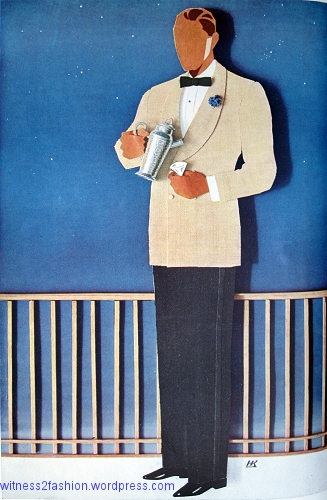
An off-white, double-breasted dinner jacket worn with tuxedo trousers. Esquire, July 1934.
In 1934, Esquire magazine reminded readers that for summer and resort wear, the tuxedo was not the only option for “black tie” evening dress.
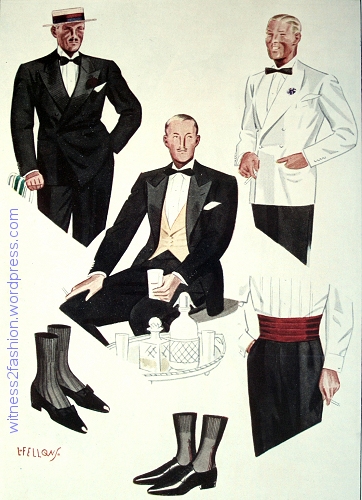
“A Few Suggestions for Saturday Night;” Black Tie options for August, 1934, from Esquire magazine.
“White Tie” describes the most formal evening dress for men; “Black Tie” is less formal, and less uncomfortable, since a starched bib-front shirt, white vest, and scratchy, rigid collar were not necessary with a tuxedo.
The Tuxedo was named after a resort called Tuxedo Park, but according to one club member, “I was brought up believing that no one called it a tuxedo. It was always called a dinner jacket.” From a history of the tuxedo in Wall Street Journal.
In the late 1800’s, the outfit we now call a tuxedo was worn only when ladies were not present, or at family dinners in the era when men and women “dressed” for dinner. But, by the 1920’s, many men wore “black tie” to dances, nightclubs, and fine restaurants. This illustration shows three black tie variations from 1934:

Left, a double-breasted tuxedo in midnight blue; center, a single-breasted black tuxedo worn with a light colored vest (a black vest was more common, but this was for summer.) Right, a white dinner jacket, also double-breasted. Esquire, August 1934. Both peaked lapels and shawl collars were acceptable.
The wider bow tie, called a bat tie, went with a soft-collared shirt.
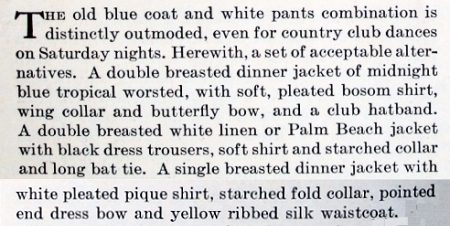
“Palm Beach” was a brand name; it indicated a summer fabric that was washable, and could refer to the cloth or to a suit made from it.
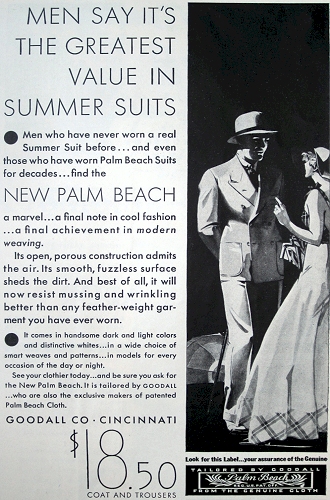
Ad for a Palm Beach suit, Esquire, July 1934.

Palm Beach label, July 1934 ad.
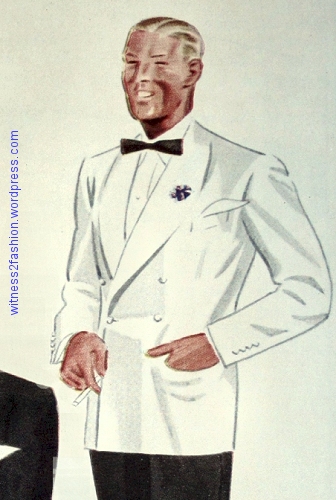
White double-breasted dinner jacket, Esquire Aug. 1934. There are four buttons, but only the bottom buttons are fastened.
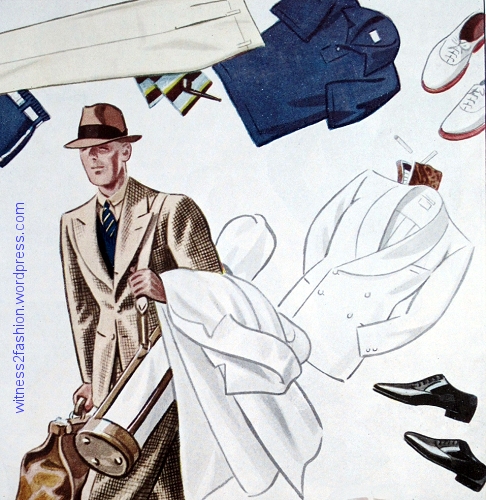
The white dinner jacket was illustrated as an essential part of his wardrobe for a weekend in the country, Esquire, Aug. 1934. Also essential: black patent shoes or pumps for “dress-up time.”
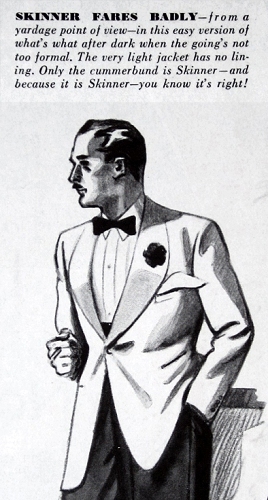
A single-breasted white dinner jacket shown in an ad for Skinner Linings. Skinner made suit linings and, in this case, the cummerbund worn with the single-button dinner jacket. Ad, Esquire, July 1934.
The white or off-white “dinner jacket” was usually worn with black tuxedo trousers. Often the dinner jacket was a warm-weather choice because it might be unlined, or half-lined (rather than fully lined) in back, and because it was not worn over a vest. [Esquire recommended double-breasted business suits for summer in 1934, because they could be worn without a vest, unlike single-breasted suits, which were usually three-piece.] The cummerbund, in black or in maroon, was coming into fashion, perhaps left over from the brief craze for wearing a waist-length mess jacket for evenings on cruises or at resorts.
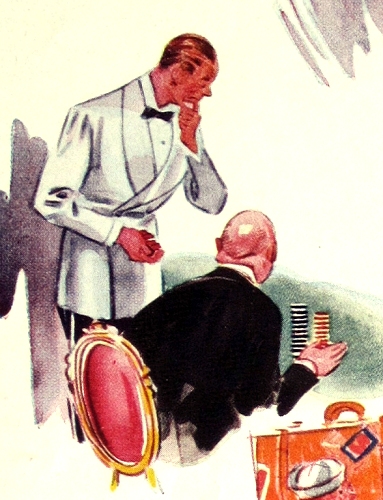
White dinner jacket from an illustration of cruise or resort wear, February 1934. Esquire, Upper left. This double-breasted jacket only has buttons at the waist.

Mess jacket with starched shirt and a black cummerbund, from an illustration of cruise and resort wear; Esquire, Top center, Feb. 1934.

Text for illustrations of cruise and resort wear, Esquire, Feb. 1934.
There had been an early thirties’ fashion for wearing a white “Mess jacket,” which was cropped at the waist like a military evening uniform (hence its name — as in “Officers’ Mess,” or dining room.) As explained at the excellent Black Tie Guide site, the white mess jacket was soon relegated to servants, barmen, and waiters.
The cummerbund, however, has been with us as a “black tie” accessory ever since; originally only worn as resort wear, in the 1930’s it slowly replaced the tuxedo vests worn in the 1920’s and was acceptable in town by the 1940’s.
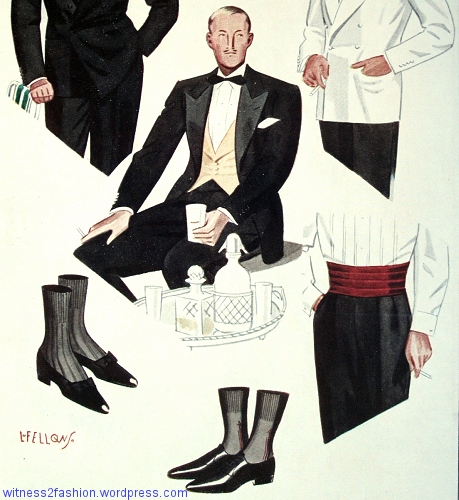
Black tie worn with a vest or with a cummerbund, Esquire, August 1934.
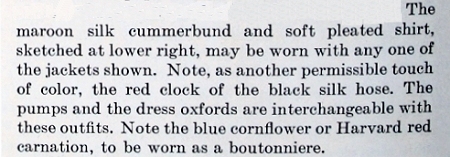

Black patent evening pumps or lace up evening shoes for men; sheer black stockings with stripes or red clocks. Aug. 1934, Esquire.
The “white” dinner jacket was not necessarily stark white; natural linen colors were also chic, as can be seen in this ad for Arrow dress shirts.

Ad for Arrow pleated dress shirts, shown with an off-white dinner jacket. Esquire, Sept. 1934. One shirt has a “regular neck band” worn with a stiff, detachable collar. The other shirt has a new, attached collar.
The pleated fronts distinguished “dress shirts” from business shirts.
Esquire ran a regular series of illustrations which used actual fabric cut into the shapes of coats, shirts, etc. This one shows the off-white color and linen-like texture used in some “white” dinner jackets.

A creamy white dinner jacket worn with a pure white shirt, plus blue bachelor button in the lapel. Esquire, July 1934.
The off-white tone of the classic dinner jacket — darker than the shirt — can be seen in this amusing clip from the movie The Lady Eve (1941.) Henry Fonda plays a wealthy but awkward herpetologist who hasn’t been in close proximity to a glamorous woman for quite some time — a situation that fortune-hunter Barbara Stanwyck corrects in this shipboard scene. Her bare-midriff dress and high heels are wonderful, too.
